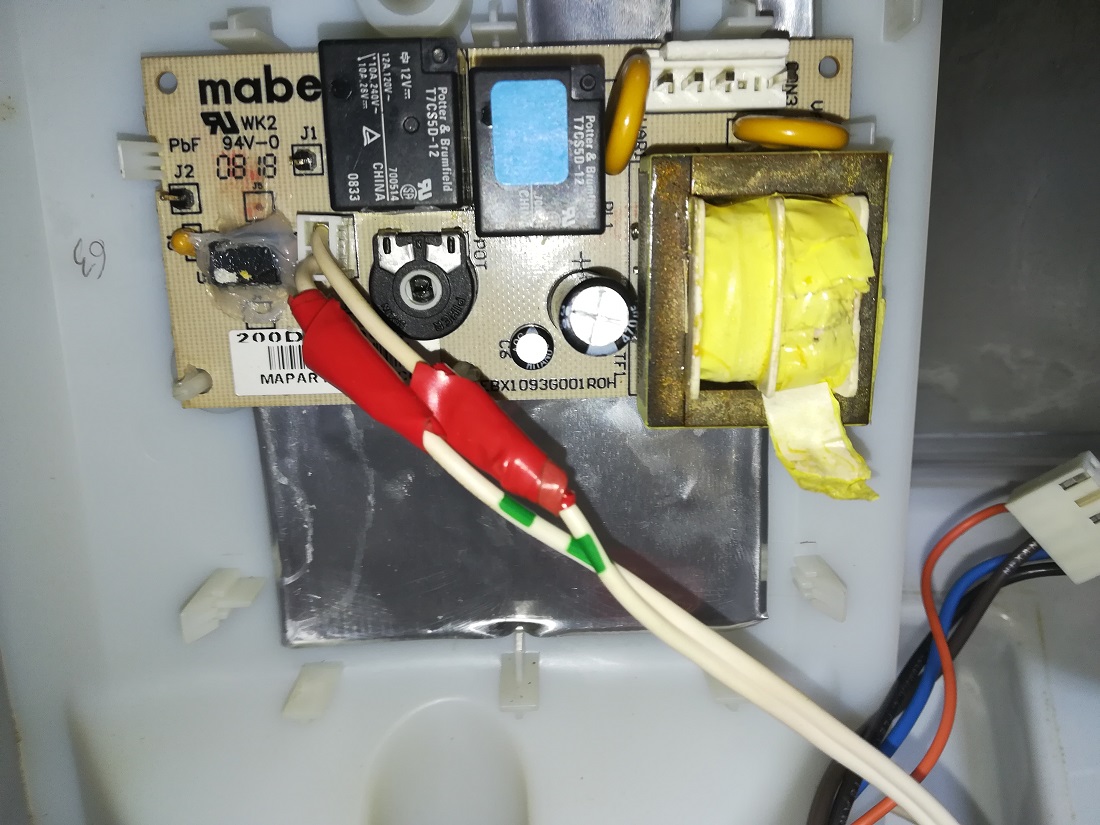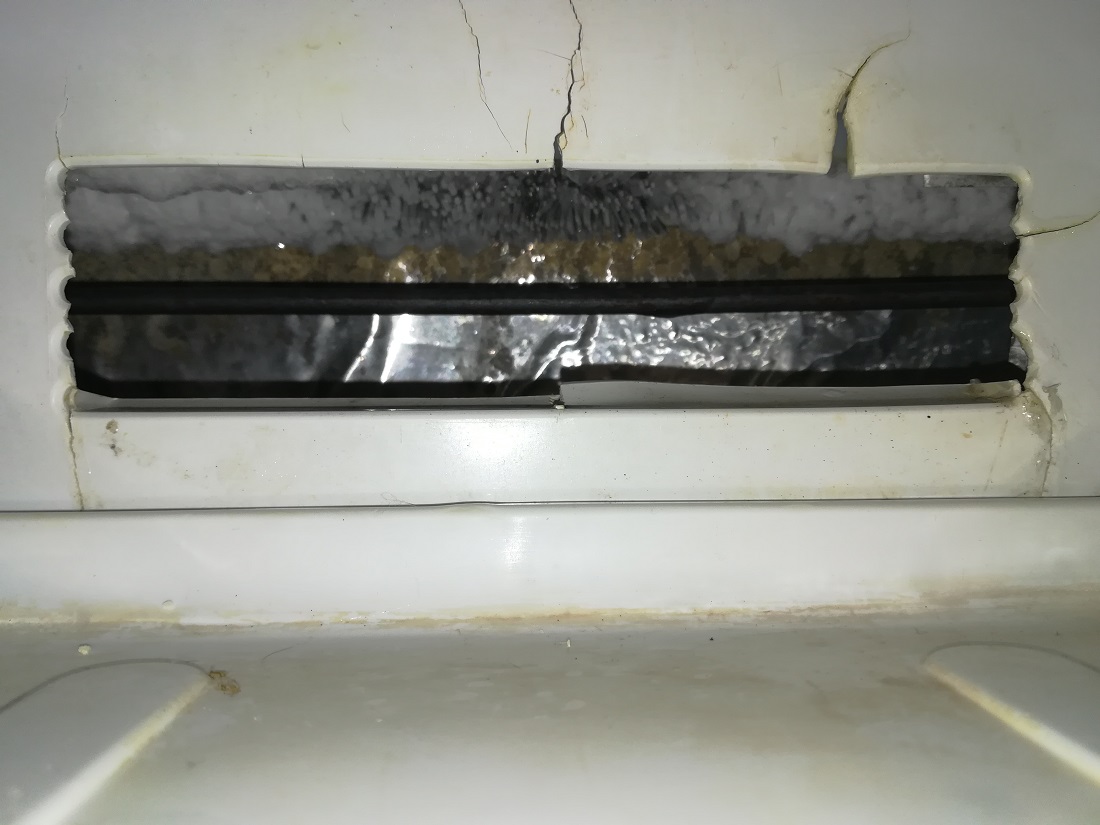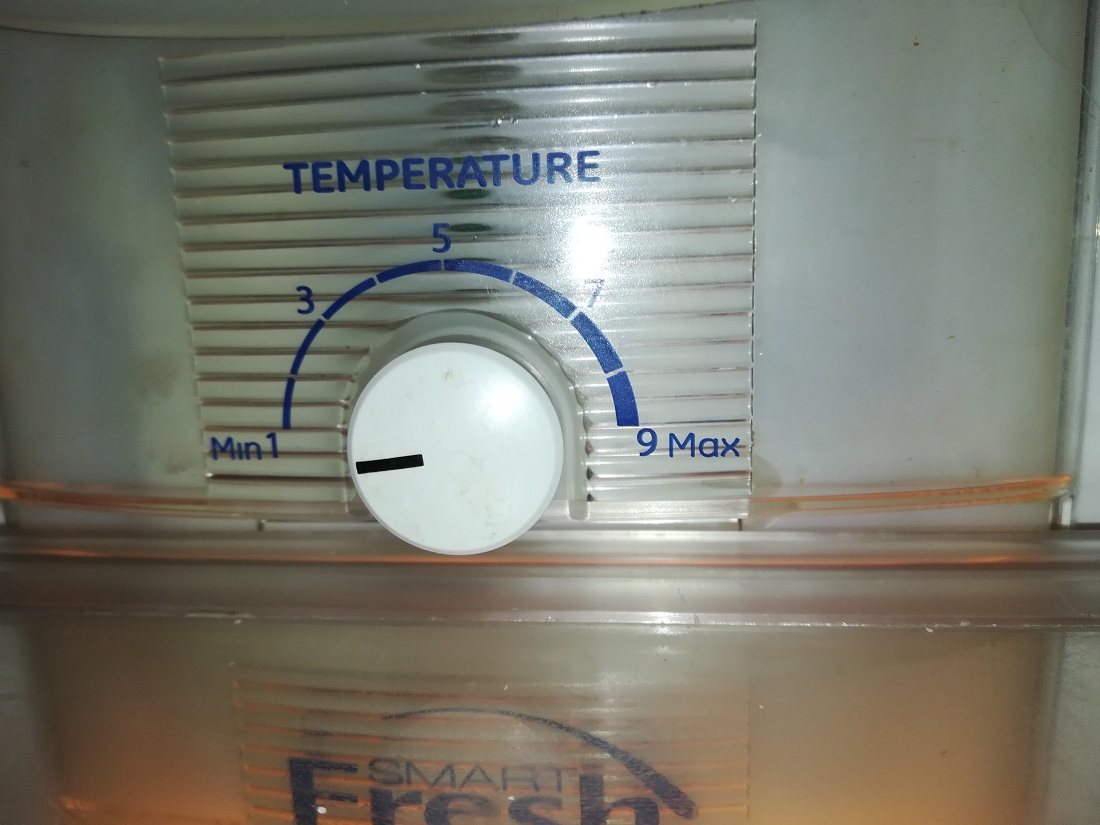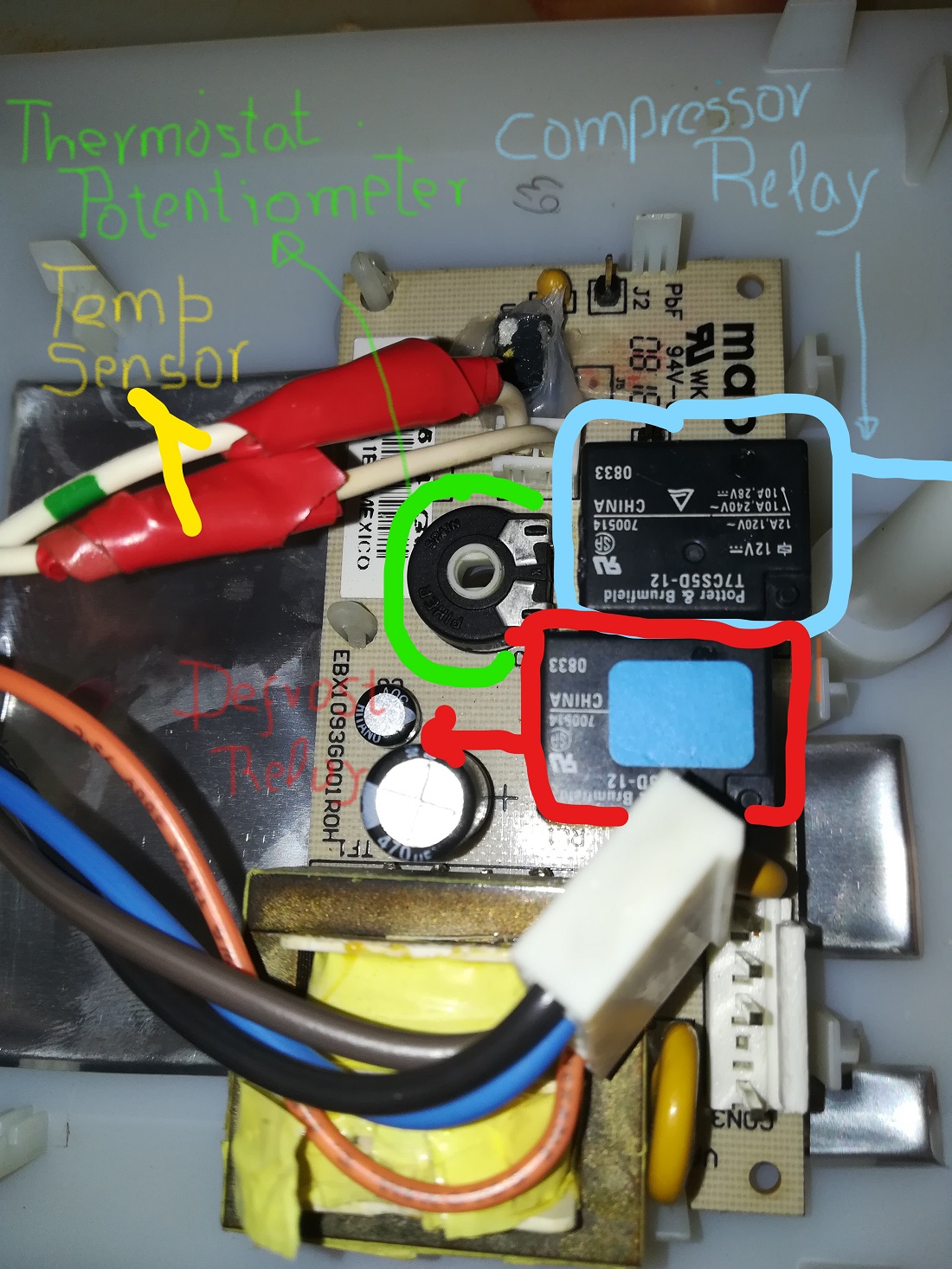As I stated in mi previous post regarding Noise coming From the Freezer, due to a lack of time because of food that needed to be refrigerated, I could not do respective tests to verify if the Thermostat, the bimetal sensor and the defrost resistance were working properly.
Como dije en mi post anterior sobre Ruido procedente del Congelador, por falta de tiempo debido a los alimentos que debían ser refrigerados, no pude hacer las pruebas respectivas para verificar si el Termostato, el sensor bimetálico y la resistencia de descongelación funcionaban correctamente

Electronic card that controls time, Temp and Defrost / Tarjeta Electrónica que controla tiempo, Temp y descongelación
Evidently, the very first day after I did all the maintenance, I was not feeling very keen on doing any more work on the fridge, mainly because it was already late afternoon and as the saying goes “At Night All Cats are Brown”, meaning that when late we may mistake some things for others. So, I just let it run to monitor its “behaviour”.
Knowing that the reason for which I intervened the fridge was the noise coming from the freezer compartment due to the built-up ice, I knew that the defrosting resistor was not coming on, and that could had been due to the bimetal sensor or a blown fuse that this resistor has connected to its ends, or the Timer or digital clock on the card or Printed Circuit Board, PCB, was not doing its job to make the defrosting relay to close contacts to feed the resistor, or the thermostat was leaving the compressor working for long periods of time.
Evidentemente, el primer día después de hacer todo el mantenimiento, no me apetecía mucho hacer más trabajos en la nevera, principalmente porque ya era tarde y como dice el refrán "De noche todos los gatos son pardos", lo que significa que cuando es tarde podemos confundir unas cosas con otras. Así que lo dejé funcionar para monitorear su "comportamiento".
Sabiendo que el motivo por el que intervine la nevera era el ruido que salía del congelador debido al hielo acumulado, supe que la resistencia de descongelación no entraba en funcionamiento, y que podía ser debido al sensor bimetálico o a un fusible fundido que esta resistencia tiene conectado en sus extremos, o que el Timer o reloj digital de la tarjeta o Printed Circuit Board, PCB, no estaba haciendo su trabajo para que el relé de descongelación cerrara los contactos para alimentar la resistencia, o que el termostato estaba dejando el compresor funcionando durante largos periodos de tiempo.

Ice starting to build up just above the resistor / Hielo comenzando a formarse justo arriba de la resistencia.
Before getting on to perform any test, I “digged” around to find out the electric schematic that applies to this fridge model. From there on, find out, at least, what type of timer it had, either mechanic, electronic or the so-called digital timer, as well as where it was located, the type of thermostat, how high the value or the resistance was in ohms, since I already knew where the latter was located as well as the bimetal sensor.
It so happened that while looking for the information regarding the features of the fridge components, the freezer compartment was converting any liquid in it, in ice literally. That made me think that the compressor was on for too long periods. So, I decided to measure the time the compressor was on and how long off, if any. After a couple of days, I timed these two periods in more than 4 hrs. for being on, and 1.5 hrs. for being off. Besides this, I did not see the resistance coming on. From here I concluded that the building ice was going to grow no matter what.
Antes de ponerme a realizar cualquier prueba, " indague" para averiguar el esquema eléctrico que corresponde a este modelo de nevera. A partir de allí, averiguar, al menos, qué tipo de temporizador tenía, ya sea mecánico, electrónico o el llamado temporizador digital, así como dónde estaba ubicado, el tipo de termostato, cuánto era el valor o la resistencia en Ohmios, pues ya sabía dónde se encontraba este último así como el sensor bimetálico.
Sucedió que mientras buscaba la información sobre las características de los componentes de la nevera, el compartimento del congelador estaba convirtiendo cualquier líquido en él, en hielo literalmente. Eso me hizo pensar que el compresor estaba encendido durante demasiado tiempo. Así que decidí medir el tiempo que el compresor estaba encendido y el tiempo que estaba apagado, si es que lo estaba. Después de un par de días, cronometré estos dos periodos en más de 4 hrs. de encendido, y 1.5 hrs. de apagado. Además de esto, no vi que la resistencia se encendiera. A partir de aquí concluí que el hielo que se acumulaba iba a crecer pase lo que pase.

Eveything frozen / Todo congelado
Before disassembling the freezer compartment once again, the very first thing to check was to make sure the thermostat was working properly. For that I just turned the thermostat knob down, waiting to hear the compressor coming off. That did not happen. With a mechanical thermostat, one expects to hear a “click”, but I did not.
Antes de volver a desarmar el congelador, lo primero que había que comprobar era que el termostato funcionara correctamente. Para ello, simplemente giré el mando del termostato hacia abajo, esperando escuchar el apagado del compresor. No fue así. Con un termostato mecánico, uno espera oír un "clic", pero no fue así.

Temperature Control knob down to min / Perilla de control de temperatura ajustada al min.
This new symptom guided me to find out the type of thermostat or temperature sensor the fridge had. In the end it was what is called an “Electronic Thermostat” since a temp sensor feeds its signal to an electronic card, or PCB. Here, the circuitry compares it to a set value and decides whether to leave the compressor ON or just turn it OFF.
I finally decided to have a look at the PCB that controls the timer, the coming ON and OFF of the compressor as well as the defrosting resistor.
Once the PCB Controller card was dismounted, I realized that the pin connecting the Thermostat potentiometer to the Temp knob was loose. To me it meant that turning the control temp knob did not cause any effect whatsoever.
Este nuevo síntoma me llevó a averiguar el tipo de termostato o sensor de temperatura que tenía la nevera. Al final era lo que se llama un "termostato electrónico", ya que un sensor de temperatura alimenta su señal a una tarjeta electrónica, o PCB. Aquí, el circuito lo compara con un valor establecido y decide si dejar el compresor encendido o simplemente apagarlo.
Finalmente decidí echar un vistazo al PCB que controla el temporizador, el encendido y apagado del compresor, así como la resistencia de descongelación.
Una vez desmontada la tarjeta PCB de Control, me di cuenta que el pin que conectaba el potenciómetro del termostato con la perilla de ajuste de temperatura estaba suelto. Para mí significaba que al girar el mando de temp. no causaba ningún efecto.

Electronic Card identifying some components / Tarjeta Electrónica donde se identifican algunos componentes
In a very simple manner, I glued the pin to the potentiometer using some liquid silicon, reassembled everything back together and plugged the refrigerator to the mains supply.
Setting the Temp knob to 3 and a half of the setting scale, the following results followed:
De manera muy sencilla, pegué el pin al potenciómetro con un poco de silicon líquido, volví a montar todo y conecté la nevera a la red eléctrica.
Ajustando el mando de la temperatura a 3 y medio de la escala, se obtuvo los siguientes resultados:

Temp Control knob asjusted just above 3 / Perilla de control de Temp ajustada sobre 3
Compressor time ON for less than 60 mins
Compressor time OFF for less than 45 mins
Defrosting Resistance time ON for less than 25 min
Tiempo del compresor ON durante menos de 60 min.
Tiempo del compresor OFF durante menos de 45 min.
Tiempo de resistencia de descongelación ON durante menos de 25 min.

Defrosting Resistance being heated to melt accumulated ice / Resistencia de Descongelado siendo calentada para derretir el hielo acumulado
This all was measured at an outside temperature of 31.5 °C
Todo esto se midió a una temperatura exterior de 31,5 °C

May I say that since then, the fridge has been functioning as it should.
Puedo decir que desde entonces, la nevera ha funcionado como debía.
All pictures are of my own

Saludos ante todo, me encanto lo sencillo pero detallado de la imagen de la tarjeta electrónica con algunos componentes identificados, más que todo porque ya en si misma implica un banco de conocimiento bastante complejo ya que estos modelos de nevera son dificiles de detallar en la internet y mucha de la informacion de apoyo tecnico ha sido perdida, de resto es una publicacion super solida como siempre en sus manos, un abrazo y espero verle de nuevo pronto en Hivemotors :)
Siempre agradezco tus comentarios porque estimulan a crecer.
Procuraré vernos pronto nuevamente por acá, aunque he estado algo inactivo por indisposición de salud.
Ahora ya superado el desafío, me verán por acá con más frecuencia.
Saludos, cuidate.Cálido saludos @jesustiano.